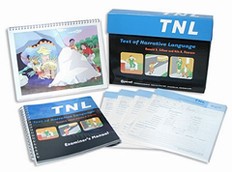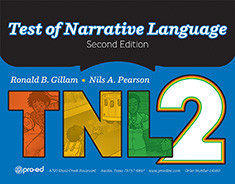*DISCONTINUED (*NEW EDITION in Alternatives below)
The Test of Narrative Language (TNL) is an easy-to-administer test that:
»»identifies language impairments
»»measures the ability to answer literal and inferential comprehension questions
»»measures how well children use language in narrative discourse
»»serves as a natural complement to other standardized tests.
Whereas most measures of children’s language examine the children's knowledge of the components of language, the TNL assesses how well children use their knowledge of the components of language as they engage in functional discourse.
About the TNL
The TNL utilizes three narrative formats that elicit scripts, personal narratives, and fictional narratives:
No Picture cues:
»» Examiners tell a story about two children who go to McDonald's with their mother
»» Children answer comprehension questions
»» Children retell the story
Sequence Picture cues:
»» Examiners tell a story that corresponds to five pictures about a class project that’s ruined
»» Children answer comprehension questions about the story
»» Children tell a story that corresponds to five pictures about a boy who is late for school
Single Picture cues:
»» Examiners tell a story that corresponds to a picture about a dragon in a cave
»» Children answer comprehension questions about the story
»» Children tell a story that corresponds to a picture about aliens landing in a park
The examiner audiotapes the administration of the TNL for later scoring on the user-friendly TNL Examiner Record Booklet. The three formats yield standard scores and percentile ranks for Narrative Comprehension and Oral Narration, and an overall standard score called the Index of Narrative Language Ability.
Features of the TNL
»»Normed on 1,059 children from 20 states
»»High validity and reliability
»»Minimal gender, racial, and ethnic bias
»»Scores highly correlated with language sample analyses
»»High sensitivity (.92) and specificity (.87) values that support the use of the test for identifying children with language impairments

 Proud to be Canadian
Proud to be Canadian
